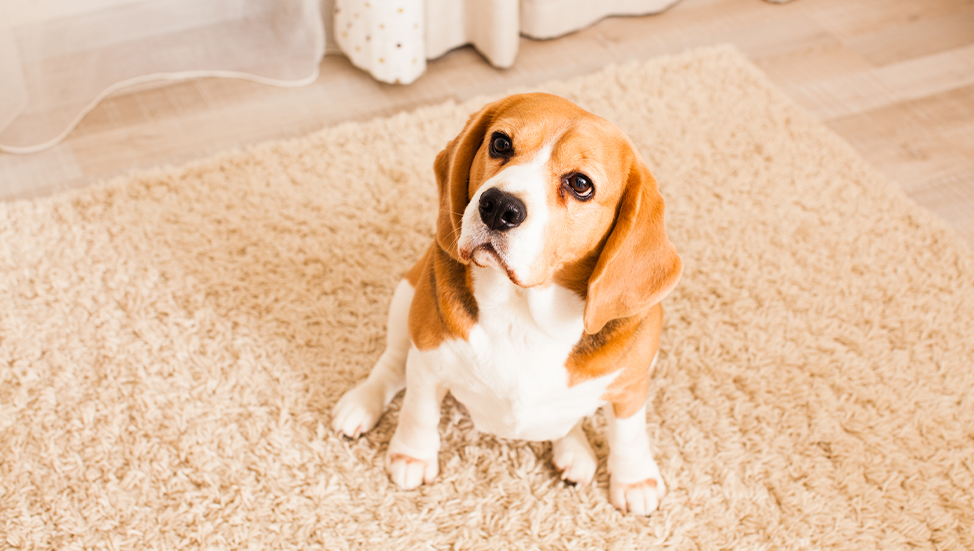Ask Dr. Jenn: Why does my dog drag her back end across the carpet?
When your dog drags his or her behind on the carpet, it's usually for the reason that you think. It's itchy! But the cause behind the itch is what most pet parents don't realize- and a trip to the vet or groomer might be necessary.

Q: Why does my dog drag her butt across the floor?
A: Oh yes, the dreaded boot scoot across the carpet. With her hind legs stretched out on the ground and her tail in the air, my little dog drags herself from one end of the living room rug to the other. It happens every couple of months and it’s usually accompanied by the screams of my children, “Mom, what is Rey doing??? Is she ok?” and my husband yelling, “She better not stain the rug!!!”
The When and Why
When a dog drags his or her back end across the ground, it is because the perianal area (skin around the anus) is itchy or irritated. The most common cause for this is full anal sacs.
What are anal sacs? That sounds disgusting! Yeah, they kind of are disgusting. Dogs and cats have two sacs on either side of their rectum. The anal gland sits inside the sac and produces a brown, oily, pungent-smelling fluid that is stored in the sacs. When a dog or cat defecates, stool pushes on the sacs causing them to release a small amount of this fluid that passes out with the stool. It is thought that the anal gland fluid serves as a way for animals to mark their territory when they defecate.
Sometimes the sacs don’t empty properly or the gland produces an excess amount of fluid. The full sac is irritating and dogs scoot across the ground to put pressure on the anal area and release some of the fluid. Cats (and some dogs) are usually too dignified to scoot but they will lick their back end excessively when the sacs get too full.
The How
If your dog is scooting, a trip to the vet or the groomer is recommended to have the sacs emptied. You can learn to do it yourself, but given the proximity to the rectum and the foul smelling material that comes out, many pet parents prefer to leave it to the professionals. Sometimes an infection forms in the sac causing an abscess. The sac fills with pus and may even rupture. Anal gland abscesses are usually very painful and require medical treatment. In these cases, the animals usually do not scoot, but will lick excessively, hold their tails down, and may cry out when their back end is touched. You may see a bright red swelling around the anus, which is a good indicator of an abscess.
The Who
Anal sac issues can affect any dog, male or female, young or old, big or small. But I tend to see the problem more commonly in smaller dogs. Some dogs may never have an anal sac issue, others just once or twice in their life, still others, like my little dog, need their sacs emptied every two to three months. A lot of different factors contribute to full anal sacs, including anatomic problems, but one common factor is soft stool. If the stool is too soft, it won’t put pressure on the sacs so they don’t empty. Adding fiber to your dog’s diet may help prevent future anal sac issues. Talk with your veterinarian for dietary recommendations.
Another common cause of scooting is allergies. In dogs, allergies to both environmental and food allergens usually manifest as recurrent skin problems, such as itchy skin and recurrent skin infections. If the skin in the perineum area is affected, dogs will scoot across the carpet to itch the area. They also lick and chew at their back end causing inflamed skin and hair loss. Often times the pet is very uncomfortable and may even be painful enough to bite. If you dog is constantly licking his back end and the skin is red and chapped but the anal sacs are empty, your dog may have allergies. Your veterinarian can help you determine the best way to manage allergies in your pet.
The Myth
There is an old wife’s tail that has been around for years – dogs scoot because they have worms. This thought was probably extrapolated from pinworm infestation in people, which causes an itchy perianal area, especially in children. Fortunately pinworms do not affect dogs and cats. Hookworms and roundworms, common parasites in dogs and cats do not cause irritation to the perianal area. Tapeworms pass segments in the stool which stick to the fur around the back end which can lead to scooting, but it is much less common than full anal sacs or allergies.
The Conclusion
There are many other possible reasons why your dog scoots across the carpet. If your pet is scooting, I recommend a trip to the vet to figure out the underlying cause.
Give your furry friend a pet for me,
Dr. Jenn
Ready to start saving money on pet wellness care?
Then take a look at Mint Wellness, the pet wellness plan that provides fast reimbursement on routine pet care. Save on vaccinations, wellness exams, preventatives, dental, and more!
Learn More


